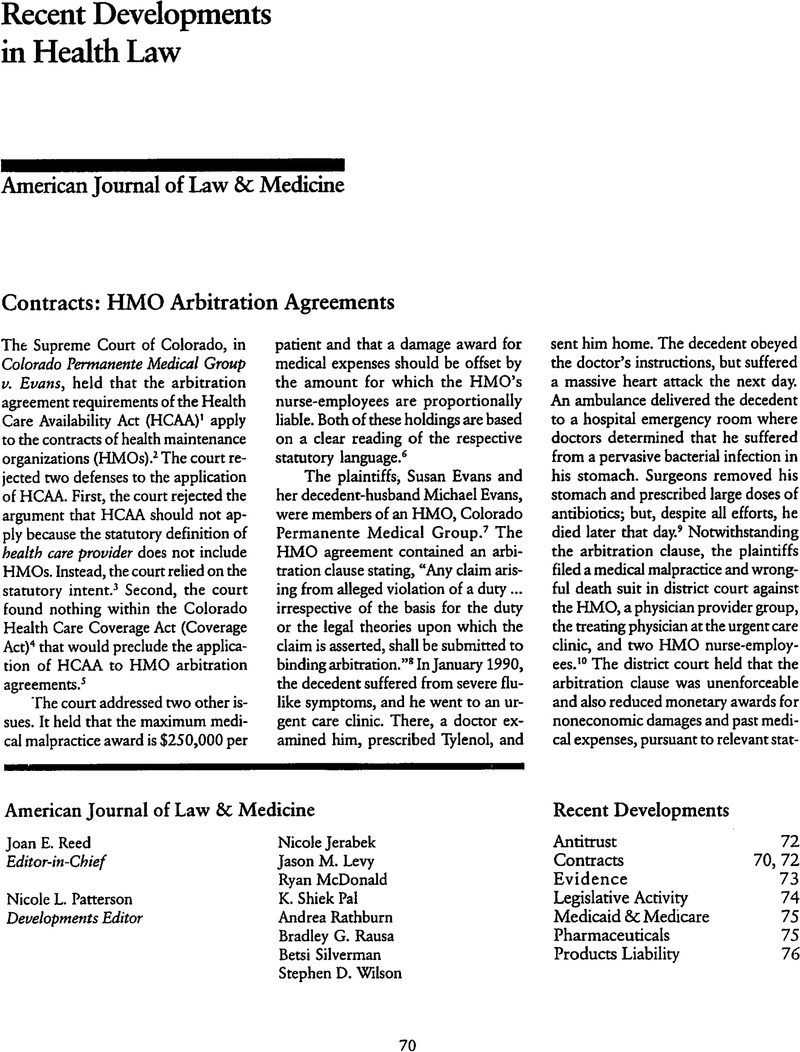No CrossRef data available.
Article contents
Recent Developments in Health Law
Published online by Cambridge University Press: 01 January 2021
Abstract
An abstract is not available for this content so a preview has been provided. Please use the Get access link above for information on how to access this content.

- Type
- Other
- Information
- Copyright
- Copyright © American Society of Law, Medicine and Ethics 1997
References
References
See id. at 1226.Google Scholar
Colo. Rev. Stat. §§ 10-16-101 to – 512, 4A (1994 & 1996 Supp.).Google Scholar
See id. at 1227.Google Scholar
See id. at 1230, 1231.Google Scholar
See id. at 1221. Colorado Permanente Medical Group was also the decedent's insurer. See id. at 1222.Google Scholar
Id. at 1222 n.8.Google Scholar
See id. at 1221.Google Scholar
See id. at 1218, 1222.Google Scholar
See id. at 1222.Google Scholar
See id. at 1222–23.Google Scholar
See id. at 1224. Note that the trial court granted summary judgment against the HMO and dismissed it from the lawsuit. See id. at 1222. The HMO did petition the Colorado Supreme Court to become one of the parties on review, but the court denied the petition because the HMO had failed to demonstrate that it had been “substantially aggrieved” by the decision of the court of appeals and that its liability for judgments against the nurses constituted an injury or burden. Id. at 1224.Google Scholar
Id. at 1224.Google Scholar
See id. at 1225.Google Scholar
See id. at 1226.Google Scholar
See id. at 1228.Google Scholar
See id. at 1227.Google Scholar
See id. at 1220–21.Google Scholar
See id. at 1229.Google Scholar
The medical malpractice damages statute provides in relevant part: The total amount recoverable for all damages for a course of care for all defendants in any civil action for damages in tort brought against a health care professional … shall not exceed one million dollars … of which not more than two hundred fifty thousand dollars, present value per patient … shall be attributable to noneconomic loss or injury. Id. at 1229 (emphasis added).Google Scholar
See id. at 1230.Google Scholar
See id. at 1222.Google Scholar
See id. at 1231. The trial court determined that the nurses' collective proportion of liability was 35 percent. See id. The portion of the past medical expenses award attributed to the urgent care clinic physician and the providers is not offset because it falls within a contract exception under the statute. See id. at 1231–32.Google Scholar
See id. at 1234 (Mullarkey, J., dissenting).Google Scholar
See id. at 1226.Google Scholar
See id. at 1230, 1231.Google Scholar
See id. at 1226.Google Scholar
See id. at 1234.Google Scholar
See id. at 1235.Google Scholar
See id. at 1234.Google Scholar
References
Freedman, B., “A Moral Theory of Informed Consent,” Hastings Center Report, 5, no. 4 (1975): 32–39; Freedman, B., “On the Rights of the Voiceless,” Journal of Medicine & Philosophy, 3 (1978): 196–225; and Freedman, B., “Competence, Marginal and Otherwise,” International Journal of Law & Psychiatry, 4 (1981): 53–72.CrossRefGoogle Scholar
Freedman, B., “Equipoise and the Ethics of Clinical Research,” New Engl. J. Med., 317 (1987): 141–45.CrossRefGoogle Scholar
Freedman, B., “Placebo-Controlled Trials and the Logic of Clinical Purpose,” IRB: A Review of Human Subjects Research, 12, no. 6 (1990): 1–6.CrossRefGoogle Scholar
To access Duty and Healing: Foundations of a Jewish Bioethics, visit: http://www.mcgill.ca/ctrg/bfreed/.Google Scholar


